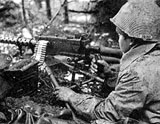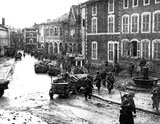 |
|||||
|
|||||
Incredible stories of real life heroes
Pvt. Shizuya Hayashi. Pvt. Mikio Hasemoto. Staff Sgt. Allan Ohata. Hayashi met the onslaught first during a flank assault on high ground held by the Germans. With bullets and grenades coming at him, Hayashi stood and charged an enemy machine-gun nest, firing his Browning Automatic Rifle from his hip. He killed nine enemy soldiers. After his platoon advanced another 200 yards, the Waialua, O‘ahu, resident took aim at enemy anti-aircraft gunners in an action that forced their withdrawal. Hayashi eliminated another nine German soldiers and captured four. Hasemoto and Ohata, both from Honolulu, were ordered to protect their platoon’s left flank against 40 Germans armed with machine guns, pistols, rifles and grenades. Two of the enemy came at them, machine guns blazing. Hasemoto fired until an enemy bullet damaged his Browning. Ohata then ran through heavy fire to Hasemoto and covered the private’s 10-yard retreat for a new weapon. Hasemoto’s new weapon also jammed, forcing him to dodge a spray of enemy bullets to retrieve an M-1 rifle. The two men continued to hold their position, killing 37 German soldiers. But it wasn’t over. The pair then charged a machine-gun nest, killing another German, wounding a second and capturing a third as he fled. And still the fighting continued. Later that same day, the two men stopped an attacking force of 14 Germans. Four more enemy soldiers were killed. Hasemoto’s luck ran out on Dec. 1 as he and Ohata grimly defended their position. He died in a hail of artillery.
Enemy machine gunners held a series of key positions, and Tech. Sgt. Yeiki Kobashigawa of the 100th Battalion could see that his platoon was in trouble. He and his men were advancing near Lanuvio, Italy, on June 2, 1944, when they came upon the Germans. The Wai‘anae resident dropped to the ground, crawled 50 yards toward one of the positions and tossed a grenade. Then Kobashigawa stood and ran toward the enemy with his submachine gun. He killed one soldier and took two prisoner but came under fire from another machine-gun nest 50 yards ahead. After directing his squad to take his newly won position, Kobashigawa and another soldier successfully attacked the second position. The platoon captured four prisoners. When the skirmish was over three hours later, two other machine-gun positions had been captured.
That same day near La Torreto, Italy, Pvt. Shinyei Nakamine, another member of the 100th Battalion, was pinned down by intense machine gun crossfire coming from a small knoll 200 yards away. Nakamine crawled to within 25 yards of one of the positions and neutralized it, killing three enemy soldiers and capturing two others when he raced at them with his submachine gun. Then the Wai‘anae native went after another position, crawling across 75 yards of deadly territory before he was close enough to throw grenades. He wounded one German soldier and captured four. But there was one more machine gun-nest, one more charge. Nakamine was killed.
The fighting on July 7, 1944, had taken the men of the 100th Battalion toward the town of Castellina, Italy, when Pfc. Kaoru Moto, serving as a scout, chose to slip forward to an enemy machine-gun position. A German gunner had halted Moto’s entire platoon, but the private from Maui managed to get within 10 paces of the man. He shot the gunner, whose partner immediately began to fire on Moto. Moto hit the ground and crawled to the rear of the machine-gun nest, where he captured the soldier. The private took his prisoner to the shelter of a nearby home. That’s when a sniper seriously wounded Moto, who just kept moving and shooting until his platoon could advance to the home. When he was finally relieved and able to seek medical aid, Moto spotted another German machine-gun position while he was crossing a road. He opened fire, wounding two of the three enemy soldiers. But instead of moving on, Moto crawled toward the men and ordered them to surrender. After two more shots at close range, the Germans gave up. Moto had three more prisoners.
Pvt. Masato Nakae was not going to surrender. Under fierce attack on Aug. 19, 1944, near Pisa, Italy, Nakae, a Honolulu soldier with the 100th Battalion, held his ground against a large enemy contingent. When his submachine gun was destroyed by a shell fragment, he grabbed an M-1 rifle from a wounded buddy and faced the advancing Germans with rifle grenades. The soldiers kept coming. Nakae forced the Germans to withdraw, however, with six fragmentation grenades. A little later, they returned, announcing the assault with a concentrated barrage of mortars. Nakae was wounded by a shell fragment. But the private kept firing back and inflicted such heavy casualties that he singlehandedly forced a second retreat.
From a hidden position on a thickly wooded ridge near Bruyeres, France, the German sniper could easily see Staff Sgt. Robert T. Kuroda. The sniper took aim. Kuroda, leading a squad from the 442nd Regimental Combat Team, already had fought a furious battle that day, Oct. 20, 1944. He and his men had come under heavy fire as they made their way to the ridgecrest. The sergeant from ‘Aiea found an enemy machine-gun nest and advanced to within 10 yards, then killed the three Germans inside with grenades. Other German soldiers homed in on Kuroda, who responded with the rest of his ammunition. That’s when he saw an officer struck down by another machine-gun nest. He rushed to the man’s assistance, but he was dead. Grabbing the officer’s submachine gun, Kuroda advanced through heavy enemy fire to the second enemy position. With deadly aim, he eliminated the threat it posed. As Kuroda turned to face another threat, a sniper’s bullet killed him where he stood.
On the same day, more than 6,600 miles away in the Pacific on a beach in Leyte, Philippine Islands, Army Capt. Francis B. Wai took charge. The first four waves of troops were in disarray and pinned down by enemy fire coming from a swampy palm grove on high ground. Wai issued orders, then headed forward - without cover - through rice paddies and rifle fire. Wai’s cool demeanor inspired the troops. They rose and followed the man from Honolulu. Again and again, as the men advanced, Wai exposed his position to draw enemy fire, hoping to locate their hidden positions. It allowed the men of the 34th Division to continue. Wai’s charge ended near the last remaining Japanese pillbox in the area. But even in death, Wai’s fearlessness inspired his men. They secured the beach.
In freezing cold, heavy fog and heavier darkness, against heavy weapons and behind enemy lines. Pvt. Barney Hajiro was in the thick of it. On Oct. 29, 1944, the Maui native stood against a German machine gun and charged 100 yards up "Suicide Hill." Like many of his comrades, Hajiro thought he was going to die there. Instead, he used his Browning Automatic Rifle to destroy two machine-gun nests. During that charge, Hajiro received six wounds, some at point-blank range. Three bullets tore into his body. One hit his face. One hit his shoulder. The last one hit his wrist. He refused aid until 40 other soldiers were treated first. Hajiro belonged to I Company, which started the battle with 200 soldiers. Only 10 survived.
Three German machine-gun nests zeroed in on Tech. Sgt. Yukio Okutsu’s platoon as it advanced on Mount Belvedere, Italy, on April 7, 1945. But as they blasted away, the sergeant with the 442nd Regimental Combat Team saw an opening. He crawled along the ground to the nearest nest, then exposed himself to gunfire to throw two grenades at the enemy just 30 yards away. Two German soldiers fell dead. Okutsu kept moving, crawling and dashing from one position to another, but always closer to the second machine-gun nest. Standing, the Kaua‘i resident threw a grenade that wounded two Germans and forced two others to surrender. But the third machine-gun position still threatened the platoon, so Okutsu made his way toward it through steady small-arms fire. He was momentarily stunned when a bullet bounced off his helmet. Then Okutsu, his submachine gun clearing a path ahead, angrily charged the rifleman who had shot at him. Several riflemen scattered in retreat. Okutsu kept going, right toward the flank of the third machine-gun nest. The four Germans surrendered.
The ridge overlooking San Terenzo, Italy, was exceptionally well defended. The Germans had placed machine guns, artillery and mortars to guard a strategic road junction. The men of the 442nd Regimental Combat Team went after the position. In their ranks that day, April 21, 1945, was Lt. Daniel Inouye, who led a platoon through a hail of automatic weapon fire. The Honolulu resident directed his men in a circling movement, and they captured a key artillery and mortar observation post. They were barely 40 yards away from the largest group of German soldiers, who were fanatically fighting from bunkers and rock formations. The Germans halted their advance. Inouye crawled up the treacherous slope. When he was 15 feet from the nearest machine gun, he destroyed it with two grenades. Then he stood, aimed his submachine gun at a second nest of Germans and blasted away. A sniper’s bullet found Inouye, but it wasn’t enough to stop him as he raked enemy positions. An exploding grenade did what the sniper could not, shattering Inouye’s right arm below the elbow. And yet, the lieutenant wouldn’t back away. Although in intense pain, Inouye refused evacuation to safety and continued to direct his men until the German resistance was broken. When the attack was over, 25 enemy soldiers had been killed, and eight taken prisoner. And Inouye’s arm was gone.
|
|||||
|
Designed by Doug Masuda • Advertiser Web Designer © COPYRIGHT 2000 The Honolulu Advertiser, a division of Gannett Co. Inc. |

